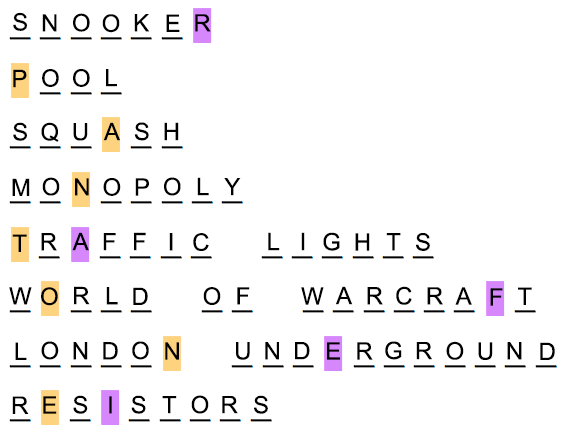| Home Register Puzzles Solve Teams Statistics Rules Solving Guide F.A.Q. Archive mezzacotta |
Solution: 3D. Swatches
We have eight sequences of colours, and eight items below. It seems clear that we are meant to identify something associated with each colour sequence and place its name in the spaces below. We then expect a message to be formed by the highlighted letters.
It can be easy to get a bit lost here and not know where to start, but one sequence at least should be very familiar: The fifth item is the colours associated with traffic lights. And good news, TRAFFIC LIGHTS fits exactly into the fifth set of letter blanks. Some of the other sequences are recognisable with a bit of thought (or searching), while others may require some inspiration. The list in full is:
- Ball colours in snooker, arranged in increasing points order from red (1 point) to black (7 points).
- Ball colours in pool, arranged in increasing numerical order from 1 to 15.
- Dot colours on squash balls, arranged in order of decreasing ball "speed".[1]
- Property colours in the board game Monopoly.[2]
- Traffic light signal colours.
- Colours indicating Item quality in World of Warcraft, in increasing order of quality.
- Colours used on maps for the various lines of the London Underground, listed in the conventional order found on the official Tube map.
- The electronic colour code used by resistors.
We can now fill in the spaces below with the associated terms:

Doing so gives us two words: PANTONE from the orange letters, and RAFEI from the purple ones.
Pantone is the company responsible for standardised colours in printing (and some other fields), which is promising for a puzzle themed around colours. The guides that they produce for colour selection consist of many colour swatches, which brings us back to the puzzle title. However, the meaning of RAFEI is rather less clear; a web search might turn up video game art director Bob Rafei, but this seems at best a tangential connection.
Digging a little deeper into the Pantone colour system, we see that each colour in the system has both a name and a code; the code has the form dd-dddd. The key insight at this step is that RAFEI is not to be interpreted as letters; instead, the letters should be converted to numbers in the standard way (A=2, B=2, ... Z=26) and then those numbers should be treated as a Pantone code. The gap between R and AFEI in the word blanks might hint at the separation of the numbers into the two parts of the colour code, on either side of the dash.
Applying this process converts RAFEI converts to 18-1659, which is the Pantone code for the colour named Goji Berry. The answer is GOJI BERRY.
Puzzle design notes
[1] Squash ball speed is a measure of how bouncy the balls are. Novices play with bouncier balls, while professionals use less bouncy ones. The final orange dot ball is specially designed for play in high altitudes and is even less bouncy. The dot colours are not uniform worldwide, with the USA tending to use green dot balls, while the rest of the world prefers a white dot to mark balls of the same speed.
[2] The colours of the properties in Monopoly are not entirely consistent either. When I grew up, the cheapest properties were a dark purple colour. While researching to remind myself of all the colours, I found references to the cheapest properties being brown. A little bit of reading revealed that the American Monopoly board, based on street names from Atlantic City, used brown. Outside North America, the more usual Monopoly set uses streets from London. I assumed that the purple/brown split was between American and rest-of-the-world boards. It was only when hint 2 for this puzzle was released, mentioning this distinction, that a team emailed to say that the colour was actually the same worldwide, and that the change was temporal, being dark purple across all Monopoly sets published before 2008, and brown afterwards. Not having played Monopoly for at least 15 years (in fact actively avoiding it, because it is a prime example of an unfun game, and there are much, much better board games in existence), I had no idea!
